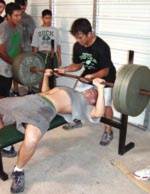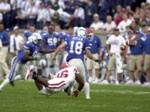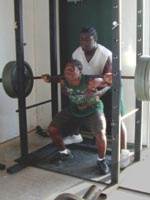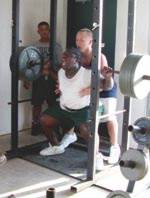Have Miracle Program Will MigrateFootball Coach Tim Holt turns around one losing program after anotherBy By Kim Goss Published: Fall 2003 After a disappointing 2-8 season in 1998, which included a disastrous 0-62 loss, head football coach Tim Holt of Gregory Portland High School decided his school needed help. He turned to BFS clinician Jeff Scurran, who flew to Portland, Texas, to deliver a BFS clinic. "We wanted to sell the community on the value of strength and conditioning, not just for football but for all sports." They got their money's worth. The next year the Portland High team improved its record to 5-5, then followed that up with a 9-1 season, including a victory over long-time rival Corpus Christi Calallen, the team that had whipped them 0-62. Coach Holt says the team didn't have to wait for a winning season to experience a winning spirit: "The greatest thing about BFS is the constant motivation that takes place with its reward system. Also, the soreness is just not there from maintaining a steady program throughout the year -- we don't lighten up at all." Having fulfilled many of his goals at Portland High, Coach Holt sought out a new challenge. That challenge was Taylor High School in Taylor, Texas. Before Holt's arrival, the Taylor High Ducks had suffered a combined two-season record of 6-14. Although Holt had only the last half of off-season to get his athletes in top shape with the BFS program, he led his team to an 8-3 finish and an invitation to the playoffs. At this point the Ducks were elevated to Division 4A, and despite their school having only 902 students, they would now compete against many schools with over 1800 students. In addition to delivering success on the field, the BFS program made his athletes unbelievably strong, fast, Holt says. In February of 2002, Taylor had 7 athletes who could deadlift 365 and 25 who could bench 205. Exactly one year later 47 athletes could deadlift 365 and 45 could bench 205. Instead of 20 athletes, 32 could run 5.0 in the 40; and instead of one athlete, 11 athletes could jump 27 inches. Pre Coach Holt, the Ducks had been known for having great athletes in the skill positions, but having no offensive line. Having a strong offensive line helps you control the ball and rest your defense. "Our standard for offensive linemen is a 500-pound squat-that's where we want our seniors to be," says Holt. Bringing the Message Home Holt is convinced that one of the reasons for his success, not just in football, was being able to sell all the coaches on the BFS program, even down to the junior high level with the BFS Readiness Program. He says "winning helps" sell other coaches on a unified program, but what can really make a difference is bringing in an outsider to champion your cause. "It's like being a prophet in your hometown," says Holt of the tendency of a community to be convinced more by an outside expert than a local one. "BFS is the most widely known conditioning program used by high schools in the United States, and to have one of their people come in and tell your boosters that you need a unified program can really help get it on its feet." The power of a unified program that includes a BFS Readiness Program at the junior high level becomes clear when you look at who was breaking all the weight training records in football at Taylor. "Every weight training record is held by a sophomore or junior, which is a tell-tale sign that prior to the BFS program the athletes were not getting the development throughout the program as they were coming up. The girls' program has similar results, as they have broken every record they had as well." Before his years at Portland and Taylor, Holt had coached at George West High School in George West, Texas. There, a team that hadn't won a district championship in 12 years went 5-5-1 the year Holt took over, and then went five years without a district loss. "What really made me migrate to the BFS program back in 1991 was the fact that our kids played with a lot of heart but couldn't match up physically, and they would get killed in the fourth quarter," says Holt. Holt, now beginning his 20th year coaching, believes that athletes have greater challenges than they did when he started coaching, "but they also have greater opportunities because so much research is available now in weight training, speed development and nutrition." One of Holt's former athletes who capitalized on those opportunities to fulfill his potential is Keith Boyer. Boyer was a starting quarterback at George West. When he was a sophomore in high school he squatted 185 pounds and ran 5.2 in the 40. Says Holt, "Keith was very dedicated to what we were trying to do with conditioning. When he graduated from high school he more than doubled his squat and ran 4.4. And because of his dedication to our weight training program, Keith became the starting quarterback at the Air Force Academy and became one of the 13 athletes in NCAA history to rush and throw for 1300 yards in a season. My question is, 'What would have happened to that kid who squatted 185 and ran 5.2 had he not participated in a program like Bigger Faster Stronger?'" Chuck Peterson, offensive coordinator coach at Air Force, agrees, saying that he is impressed not only with Holt's ability to develop athletes through a strong strength and conditioning program but also with his devotion to getting those talented athletes seen by college coaches. Among the athletes on the current teams, Holt cites four players who he feels certain have the potential to play at the Division I level in college: • Marcus Bunton, 5'9", a two-year starter at quarterback who possesses tremendous quickness. He runs 4.4 in the 40 and can squat 425 at 180 pounds bodyweight. • Daniel Thomas, 5'9", a two-year starter at running back, a former class president and a football team captain. He runs 4.55 in the 40, squats 565 and cleans 250 at 180 pounds bodyweight. • Tony Metoyer, 6'3", a starter on the offensive and defensive line who has tremendous mobility and is very explosive, can stand flat-footed and repeatedly touch a basketball rim with both hands. He cleans 260 and bench presses 420 at 230 pounds bodyweight. • Chris Lamar, 6', a starter on the offensive and defensive line who is the strongest kid for his age that Holt has ever seen. Weighing 295 pounds, Lamar has done a 625-pound squat in powerlifting competition, up from 395 the previous year, and has bench pressed 405, up from 290 the previous year. In addition to his commitment to a unified strength training program, there is one factor above all that has enabled Tim Holt to turn poor football programs into great ones: discipline. "If our kids don't practice, they don't play," says Holt. "We also monitor our kids' grades once a week, and we have a consistent set of rules that we expect them to follow. We're very strict about our workouts and academics. And because we have such a strong work ethic and discipline, our kids are able to win, get into college programs and be successful." |
 |
|
RB Daniel Thomas runs 4.55 in the 40, squats 565 and cleans 250 at 180 lbs. |
 |
|
Tony Metoyer, 6'3", cleans 260 and bench presses 420 at 230 pounds bodyweight |
 |
|
Keith was very dedicated to what we were trying to do with conditioning. During high school he improved his forty time form 5.2 to 4.4. And because of his dedication to our weight training program, Keith became the starting quarterback at the Air Force Academy |
 |
|
Daniel Thomas runs 4.55 in the 40, squats 565 and cleans 250 at 180 pounds |
 |
|
Chris Lamar has done a 625-pound squat in powerlifting competition, up from 395 the previous year. |